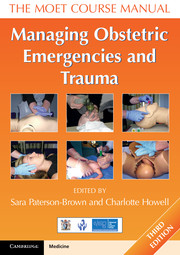Book contents
- Frontmatter
- Dedication
- Contents
- Working Group
- About the authors
- Acknowledgements
- Abbreviations
- Section 1 Introduction
- Section 2 Recognition
- Section 3 Resuscitation
- 8 Airway management and ventilation
- 9 Cardiopulmonary resuscitation in the nonpregnant and pregnant patient
- 10 Amniotic fluid embolism
- 11 Pulmonary thromboembolism
- 12 Resuscitation of the baby at birth
- Section 4 Trauma
- Section 5 Other medical and surgical emergencies
- Section 6 Obstetric emergencies
- Section 7 Triage and transfer
- Section 8 Human issues
- Index
12 - Resuscitation of the baby at birth
- Frontmatter
- Dedication
- Contents
- Working Group
- About the authors
- Acknowledgements
- Abbreviations
- Section 1 Introduction
- Section 2 Recognition
- Section 3 Resuscitation
- 8 Airway management and ventilation
- 9 Cardiopulmonary resuscitation in the nonpregnant and pregnant patient
- 10 Amniotic fluid embolism
- 11 Pulmonary thromboembolism
- 12 Resuscitation of the baby at birth
- Section 4 Trauma
- Section 5 Other medical and surgical emergencies
- Section 6 Obstetric emergencies
- Section 7 Triage and transfer
- Section 8 Human issues
- Index
Summary
Objectives
On successfully completing this topic, you will be able to:
understand the important physiological differences in the newly born baby
understand the equipment used for resuscitation at birth
understand how to assess and resuscitate the baby at birth
understand additional measures for special situations.
Introduction
The resuscitation of babies at birth is different from the resuscitation of all other age groups, and knowledge of the relevant physiology and pathophysiology is essential. However, the majority of newly born babies will establish normal respiration and circulation without help. Ideally, someone trained in newborn resuscitation should be present at all deliveries. It is advisable that those who attend deliveries attend courses such as the Newborn Life Support Course, organised by the Resuscitation Council (UK), the European Resuscitation Council or the Neonatal Resuscitation Programme, organised by the American Academy of Pediatrics. However, some babies are born in unexpected places, such as Emergency Departments. For these situations, it is important that clinicians have an understanding of the differences in resuscitating a baby at birth.
Normal physiology
At birth the baby must change from an organism with fluid-filled lungs whose respiratory function is carried out by the placenta, to a separate being whose air-filled lungs can success fully take over this function. Preparation for this begins during labour, when the fluid-producing cells within the lung cease secretion and begin re-absorption of that fluid. Delivery by CS before the onset of labour may slow the clearance of pulmonary fluid from the lungs.
- Type
- Chapter
- Information
- Managing Obstetric Emergencies and TraumaThe MOET Course Manual, pp. 139 - 156Publisher: Cambridge University PressPrint publication year: 2014



